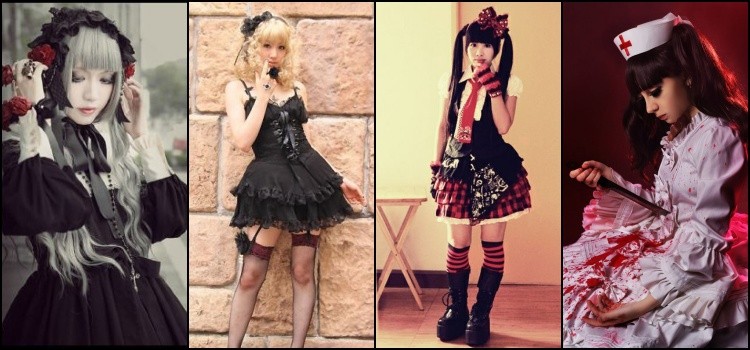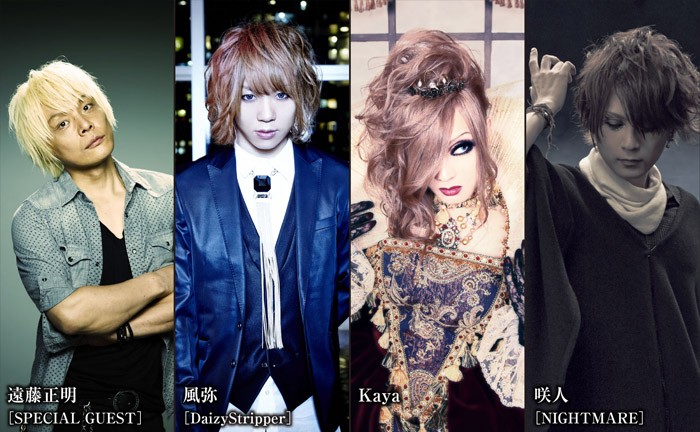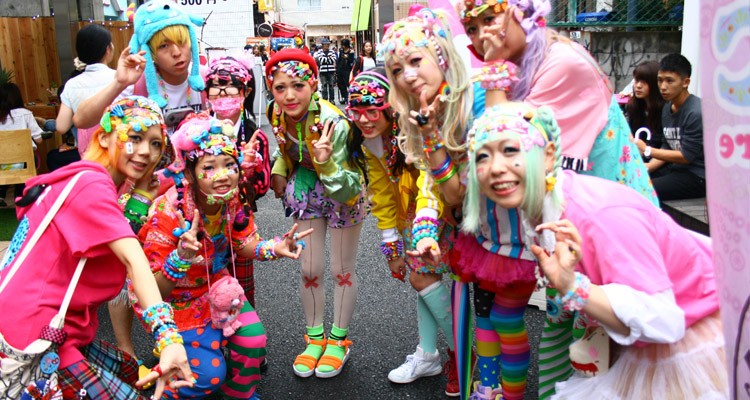Over the years Japan has stood out with its alternative fashion style that is widespread in regions like Harajuku. The main one is called Visual Kei, which generated a lot of alternatives. In this Guide we will talk about all styles of Japanese fashion.
Many of the styles explained in this article are subculture, they are many styles ending with an ideogram which literally means something like lineage, group and system that generally corresponds to a certain period of style and fashion.

Visual Kei – History and Curiosities
OVisual Keior Visual Rock is a musical and visual movement that mixes several styles of rock with Punk / Gothic hybrid characteristics that became popular in Japan in several groups of J-Pop and J-Rock.
This style was influenced by J-Rock bands like Devil Kitty and Mar Luna. In addition to Rock, Metal and Punk, Visual Kei’s music mixes classical music instruments such as violins, pianos and organs.
In japanese bizuaaru kei takes the ideogram which means style, system, group and lineage, commonly used as a suffix to refer to groups and styles of Japanese fashion that circulate Tokyo.
In other words, it is a movement among Japanese musicians that involves elaborate costumes, colored hair, striking makeup, unusual hairstyles, extravagant performances and a somewhat androgynous aesthetic.
Bạn đang xem: Visual kei là gì
History of visual kei
The movement visual kei appeared in the mid-60s / 70s, but had its peak with the appearance of some bands like Buck-Tick, Kamaitachi and Color in the 80s and extends today in the Japanese music scene.
It took dedication and time to win over the Japanese audience, as they are quite reserved in some ways, but this goal has been achieved and even today visual kei it is part of oriental culture.
Famous bands like MALICE MIZER, Moi dix Mois, Luna Sea and Versailles were influenced by the Visual Kei movement. Even Solos singers adhere to the style with haircuts and flashy clothes.

Visual Kei in Brazil
In Brazil, there are several visual kei fans who, in addition to visual rock, are also interested in other forms of Japanese rock. In 2006, the J’s Fest II (Japan Song Fest II) event attracted 1,500 visitors to Circo Voador, in Rio de Janeiro, who attended, among other attractions, national bands inspired by visual kei and j-rock artists. Several events of a similar nature occur in different regions of the country frequently.
Visual kei or J-Pop is present in the lives of otaku, lovers of Japanese culture or lovers of style, not that this is a rule or fact.
Moda Decora – Knowing the Style
The decor looks can be characterized by the use of printed pieces and bags, hair clips, pebbles in the makeup, toys hanging around the neck, countless necklaces, bracelets and many colorful socks, being used at the same time, giving total freedom of choices and varieties for who will use.
Where Decora fashion emerged
The word Decora comes from “Decoration”, since that is the concept of style, along with a lot of authenticity, creativity and motivation. It is also known as the FRUiTS style, thanks to the magazine of the same name where many photos of these people are published, which are unique and circulate in Harajuku.
It is uncertain where the style came from, but I (the author), I believe it is in Harajuku, around 1990 and 1995, as it is a large urban center and known for containing several tribes.
Decor style subdivisions
Child decorate: they are the ones that use clothes, accessories, among others, of anime and otaku culture, leaving a more childish mark.
Pink decor: As the name suggests, what predominates is pink, with variations in the shade of pink and red and white being accepted.
Colorful decorate: There are no color restrictions in this category, with colorful hair and extravagant clothes, what matters is that there is no restriction.
Dark decor: Black is the main color, with variations with white, which can be characterized as a punk style of fashion decorating.
Lolita decorates or Lolicora: is a mixture of lolita with decorate. The lolitas are already of a nature full of props as well as the decorations. Lollipopers are three times more.

Some features of Decora
Fashion fans usually walk in groups of 2 to 3 people, and usually combining accessories;There are also adept boys;Girls are between 13 and 17 years old;The look is designed to attract attention, something that fashion fans themselves want;Some even wear 3 socks at the same time, all colored and decorated;The Kawaii and childlike aspect;The accessories are usually from anime characters, making the style more cute;The prevailing color is pink, not always;The decor style does not follow any pattern, so the more you abuse the look the better;Little makeup;
How is decoration accepted in society?
Decora fashion is quite popular in Japan, more precisely in the streets of Harajuku and otaku entertainment venues, usually having its target audience entirely female, with exceptions.
Japan is a very diverse and liberal country, so Decora is just one more style among many others, in Harajuku you will find people in cosplay styles, Lolita, among many others, so there is no reason to be prejudiced there, of course you can be in separate groups, but other than that, there are no problems.
The only thing that cannot be done is to use this style to go shopping, job interviews, among others, Japan is a very reserved country when it comes to everyday life, so what prevails is common sense .
Gyaru – Independent Style
Gyaru is a Japanese fashion style that originated from the jeans brand called “Gurls“. This word originated from the English “girl” and the slang “gals” used to refer to beautiful girls.
Gyaru-style girls usually mix colors, prints, sparkles and all kinds of fashion, bringing their own and very bold style to the oriental pattern. They usually do tanning, change their hair entirely, and wear thousands of exotic accessories.
Gyaru also usually has very bleached or dyed hair in shades of dark brown for blond and decorated nails. The makeup consists of dark eyeliner and false eyelashes used to make the eyes look bigger.
The garments of the gals differ depending on which gyaru style the girl chooses. They rolled theskirts to stay shorter, have their own slang and frequented specific places. They also pose with tongues when taking pictures.
Fairy Kei
Fairy Kei is a style that will satisfy anyone who loves cute things, especially for those who say, “Aaaaawn, that Kawaii …”, since fashion is mainly composed of cute things, like pastel colors, fluorescent pink, polka dots polka dots and a lot of nostalgia, Fairy Kei is a style inspired by the 80’s pop cuties!
The Style Arena website says that fashion started around 2007, when Sebastian Masudea, founder of the “6% DOKI DOKI” store decided and started to produce collections based on expressions such as: “Sensational and lovely”, “Not only cute but also happy”and“Feeling of unreality”, Sensational and kind, not only cute, but happy too, feeling the non-reality.
Other stores started to invest in fashion, thus forming Fairy Kei. The origin of the name is not known for certain, but it is explicit that the name is due to the fact that the clothes are delicate and lucid, after all, Estilo Fada is a name that lives up to fashion.
Cult Party Kei
Something that happens frequently in Japanese fashion, is that the name of the fashion was inspired by a brand, such as Dolly Kei, for example. Of course, over time, fashion will create its own aesthetic, thus having its recognition.
In the case of Cult Party Kei, even the name was removed from the Virgin Mary store, which used to be called Cult Party. The concept and focus of the brand is “Eternal Girl that creates the world”, “The eternal girl that creates your world”.
Cult Party Kei is a little more recent than other fashions, like Mori Girl and Dolly Kei, being sometimes confused with these styles, but one of the main differences is that Cult Party is more focused on Pop culture, while the others are more focused on vintage.
The clothes tend to have a lighter and more synthetic appearance, with a little flair, with the majority of stores that represent fashion having this format.
Customizations in the pieces to make them original and unique are also always welcome. The mix of Lolita accessories, Fairy Kei, together with varied pop accessories enrich the style.
Seifuku Kei
The style of fashion is precisely the focus on Japanese school uniforms, for us Brazilians this admiration for school uniforms may seem quite unusual, this is because we do not have this custom here.
Xem thêm: Nghĩa Của Từ Sồn Sồn Là Gì ? Nghĩa Của Từ Sồn Sồn Trong Tiếng Việt
The most curious thing is how this fashion fell in the taste of students.
The uniform of Japanese schools is one of the symbols of the country and is recognized anywhere in the world. However, it is not always the students’ taste, for us it is not difficult to understand why, so many are left with that desire to upgrade their own uniform, or feel the desire to have a more beautiful item.
In addition, over time, some schools are taking away the concept that uniforms are mandatory, so fashion has an influence on those who do not need to wear it, but who want to try and use it. It also comes from those alumni who miss school time.
Dolly Kei
Dolly Kei appeared in the middle of 2010. Like the Lolita style, Dolly Kei has a hint of flea market fashions, with a little focus on vintage and fantasy films. One of the reference stores for fashion is the Grimoire store, which was created by Naoaki Tobe and Hitomi Nomura.
As with drawings, references are required. The main fashion references are in films and books, such as Alice in Wonderland, Harry Potter and Narnia. The focus is also on typical folk clothes, gypsy, with a lot of embroidery, furs, heavy materials such as leather and suede. The important thing is to bring a typical reminder of a more medieval and rustic European era.
Of course, Japanese culture manages to give a unique and attractive touch to the style, maintaining a certain harmony. Unlike some fashions, Dolly Kei brings a certain reminder of Eastern European culture. Dolly Kei is a style that plays with the different layers and textures available.
Mori Girl
The Mori Girl style is recent, fashion was made for those who thought like the creator of Mori Girl, Choco. Choco spread her thoughts through a community she created on Mixi (equivalent to our Orkut, but Japanese). Choco’s thought was that of “a girl out of the forest”.
Fashion brings a desire for comfortable clothes that show romanticism and country style. Perhaps, to escape a little from the reality of the big city.
This fashion is also for those who have a more solitary lifestyle, who like to read books and who like to have coffee and tea quite calmly.
Fashion made the head of many other girls, spreading through the streets of Tokyo. Like many other fashions, Mori Girl was not left behind and had its popularity in terms of having its own magazines, clothing brands and events.
With influences from some other fashions, the Mori style brings loose floral dresses. Other accessories, such as layers of jackets, vests, scarves, knitted and / or plush hats, socks and various shoes. Colors are normally used in combination with nature to keep the focus more attractive. Fabrics are best if they are handmade, with light and delicate textures.
Despite having the word “Girl” in the name, boys are also interested in fashion. As always, adjusting in style, wearing saruel style pants, vests, jackets, scarves, handmade hats and dread in the hair. Remember that it is not necessary to be so strict in fashion.
In a Mori Girls community, a girl said, “You don’t have to be so afraid of making mistakes.” This is because it is a natural fashion, where nature is part, and the most ideal is to have a style that does not escape the extreme of standards.
Otome Kei
Otome Kei is a more casual and reserved style, which alludes to dresses from the 60s. Otome Kei is an extremely feminine and delicate casual style. Currently owning some brands, such as MILK, Axes Femme and Temple Cute.
Fashion, in terms of style, resembles Japanese kawaii culture, being similar to the Lolita style, but do not confuse the two, with otome kei having cheerful and colorful colors, as well as the sub-genre Sweet Lolita.
The format does not necessarily have to be accentuated. Also having some dresses that are under the bust, the accessories being discreet, that match the clothes you are wearing. Hair is also essential, as are berets, hats, tiaras, ribbons … Remember to keep the harmony.
Some confuse Otome Kei fashion with the Casual Lolita sub-style, as both have a similar look at first sight. Otome Kei, therefore, is a much more informal style than Casual Lolita, although well coordinated.
Casual Lolita is in fact more formal, as it requires pieces made for Lolita fashion, in different combinations or in more exclusive and unique ways.
Alternative Metamorphosis – Shironuri Fashion
It is an aesthetic subculture. It appeared on the streets of Harajuku, in 2012 it became popular, gaining new followers. A living sculpture, like a blank canvas, facial expressions are completely hidden, being able to “redraw” them.
Shironuri is a Japanese style of make-up style, with traditional origins in the makeups of artists Maiko and Geisha and the theater Kabuki. The term itself literally means “White painted”.
Its main feature is the super long lashes, and the use of Circle Lens that complement the outfit. Some crystals can be found at the height of the cheekbones, very subtle.
Since the Meiji Period (1868-1912), Japanese arts have been influenced by Fine Arts from the West. Nowadays with globalization and new technologies, the Japanese arts started a new transformation: They took all their cultural baggage and reinvented themselves, molding themselves by foreign influences.
His fashion influences are: Vintage Fashion, Kawaii, Gothic, Horror, Nature, Anime, Decora, Masquerade, Rave Culture, Cyber and many other sources.
The Shironuri style has become quite democratic, there is no rule (except for faces painted white and softly adorned) and being constantly reinvented, painting refers to different artistic contexts: You are the creator of your art.
Xem thêm: Social Media Là Gì – Sự Bùng Nổ Cho Marketing Tương Tác
Black is the most classic color in women’s hair. Shironuri, and it is the natural tone of the majority of the Japanese population, however, colorful and flashy shades giving a high contrast are quite common. They usually wear very full wigs, being straight or curly. They are usually long.
Chuyên mục: Định Nghĩa







